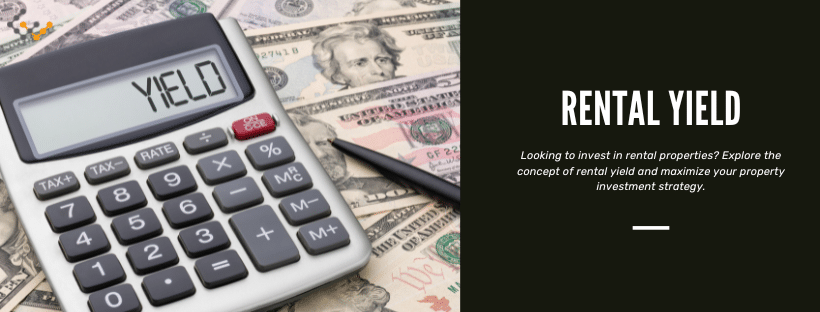How to Calculate Rental Yield on a Property

Any successful real estate investment requires understanding the profitability of said investment. While profitability can be ascertained several ways in real estate, yield is one of the most important ones if holding rental properties. A percentage-based figure, yield is one way to calculate a property’s returns against its value.
What is Rental Yield?
Rental yield shows the annual return a property generates through rent, as measured against the property’s value. It’s thus one way to measure return on investment. While not comprehensive for rental properties (e.g. it doesn’t include appreciation), the calculator measures the primary revenue stream of almost any rental property.
The purpose of rental yield is to provide an easy way of evaluating expected performance for rental real estate, and assessing how quickly an investment in the property will generate a positive return.
Rental yield is most often calculated on an annual basis and is rarely used across any other time frame.
Answer a few questions and get custom mortgage quotes. We'll match you with offers from our network of 650+ lenders.
Why Rental Yield Matters for Real Estate Investors?
Rental yield matters because it shows real estate investors what return they can expect against their property’s value. This is an objective and quantitative way to evaluate one of the most important aspects of any rental property. Investors can use the metric for multiple purposes:
- Accurately compare different properties and markets quickly
- Estimate the profitability of a specific property over time
- Make informed decisions about selling or holding an investment
- Apply for financing (rental yield is one data point lenders consider)
Therefore, rental yield is one of the most decisive factors when evaluating whether to make or keep a rental real estate investment.
Gross Rental Yield vs. Net Rental Yield
While rental yield is nearly always calculated on an annual basis, there are a couple of different ways investors might approach it. Investors may calculate gross rental yield or net rental yield.
Gross Rental Yield
Gross rental yield considers the property’s total annual rental income as a percentage of its current market value. It doesn’t take into account any expenses, like property maintenance, management fees or vacancies, providing a basic and quick insight into a property’s earning potential.
Gross rental yield is most useful when screening for potential properties, or if comparing two properties that would have similar expenses.
Net Rental Yield
Net rental yield offers a more accurate picture of a property’s actual profitability by incorporating operating costs into the calculation. These costs can include property taxes, insurance, maintenance, property management fees and others.
Because net rental yield takes into account expenses, many additional factors can impact this yield. For example:
- Building Age and Condition: Older buildings and those in worse condition typically require more extensive maintenance and repair. An increase in maintenance costs would reduce the net yield.
- Average Area Wages: Location is a primary driver of property value and rent charged, and thus directly affects both gross and net yield calculations. Net yield can also be affected by location if the location increases staff wages. Any increase in labor costs will correspond to a decrease in net yield.
- Property Amenities: Amenities may allow investors to charge more for rent or collect additional fees, but these can also increase maintenance and insurance costs. The latter half can decrease net yield. Any decrease may be offset by the increase in rent or other revenue received.
- Property Manager: The fees that a property manager charges also directly impact net yield, by increasing or decreasing operating expenses. Investors should look for a competitively priced property manager, who still provides excellent service.
- Taxes: Taxes are another necessary cost that has a negative impact on net yield. Taxes must be taken into account for this reason, and investors should be careful to retain any credits or exemptions that a property qualifies for.
Net yield is most useful when calculating the true return that a property might provide.
How to Calculate Rental Yield
Gross rental and net rental yields are calculated similarly, but with accounting for expenses when calculating net yield.
How to Calculate Gross Rental Yield
A basic formula is used to calculate gross rental yield:
The Gross Rental Yield = The Annual Rental Income / The Property Value x 100%
As an example, assume a property worth $300,000 that generates an annual rent of $24,000. The gross yield would be:
Gross Rental Yield = $24,000 / $300,000 x 100% = 8%
How to Calculate Net Rental Yield
The same formula can be used to calculate net rental yield, with only a minor change:
The Net Rental Yield = (The Annual Rental Income – Any Operating Costs) / The Property Value x 100%
Assume the same example of a $300,000 property that generates $24,000 in annual rent. The property has $4,000 in annual expenses that must also be considered. The net yield would be:
Net Rental Yield = ($24,000 – $4,000) / $300,000 x 100% = 6.67%
What is a Good Rental Yield?
What constitutes a “good” rental yield varies depending on factors like location, property type, and market conditions.
Generally speaking, a gross rental yield of 6% or higher is considered decent, while a net rental yield of 4% or higher is normally good. This correlates to operating costs equally approximately 2% of a property’s value.
How to Increase Rental Yield
Rental yield can be increased in several different ways, most of which are simply managing a rental investment property well. Some specific steps investors might take are to:
- Reduce Vacancies: Keeping a property consistently rented will ensure maximum annual rental income.
- Adjust Rents: Rents may be adjusted as market conditions require. They may be lowered if too high, so vacancies can be reduced. Rents may be increased if the market allows, in order to boost rental income.
- Efficient Management: Streamlining operational costs can substantially improve net yield, especially if operating expenses are more than the typical 2% of property value.
- Property Upgrades: Strategic renovations can increase the property’s value and rent, thus boosting your yield. Poorly planned ones could increase costs without a corresponding uptick in rent, though.
Wrapping Up
If you’re investing in any type of residential real estate, make sure you understand rental yield on both a gross and net basis. You’ll need to understand this as you evaluate current or potential rental property holdings.

